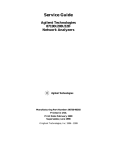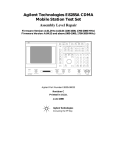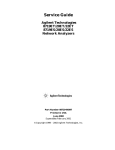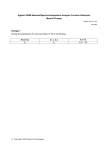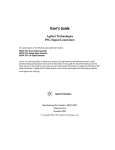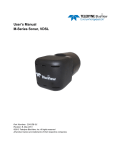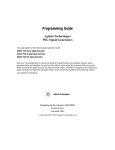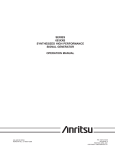Download Installation Note - Maxim Instruments Corporation
Transcript
Installation Note 8757D/E CRT to LCD Upgrade Kit Part Number 08757-60159 Agilent Part Number: 08757-90195 Printed in USA June 2003 © Copyright 2003 Agilent Technologies, Inc. All rights reserved. Notice THE MATERIAL CONTAINED IN THIS DOCUMENT IS PROVIDED “AS IS,” AND IS SUBJECT TO BEING CHANGED, WITHOUT NOTICE, IN FUTURE EDITIONS. FURTHER, TO THE MAXIMUM EXTENT PERMITTED BY APPLICABLE LAW, AGILENT DISCLAIMS ALL WARRANTIES, EITHER EXPRESS OR IMPLIED WITH REGARD TO THIS MANUAL AND ANY INFORMATION CONTAINED HEREIN, INCLUDING BUT NOT LIMITED TO THE IMPLIED WARRANTIES OF MERCHANTABILITY AND FITNESS FOR A PARTICULAR PURPOSE. AGILENT SHALL NOT BE LIABLE FOR ERRORS OR FOR INCIDENTAL OR CONSEQUENTIAL DAMAGES IN CONNECTION WITH THE FURNISHING, USE, OR PERFORMANCE OF THIS DOCUMENT OR ANY INFORMATION CONTAINED HEREIN. SHOULD AGILENT AND THE USER HAVE A SEPARATE WRITTEN AGREEMENT WITH WARRANTY TERMS COVERING THE MATERIAL IN THIS DOCUMENT THAT CONFLICT WITH THESE TERMS, THE WARRANTY TERMS IN THE SEPARATE AGREEMENT WILL CONTROL. Getting Assistance from Agilent By internet, phone, or fax, get assistance with all your test and measurement needs. Online assistance: www.agilent.com/find/assist United States (tel) 1 800 452 4844 Latin America (tel) (305) 269 7500 (fax) (305) 269 7599 Canada (tel) 1 877 894 4414 (fax) (905) 282-6495 Europe (tel) (+31) 20 547 2323 (fax) (+31) 20 547 2390 Australia (tel) 1 800 629 485 (fax) (+61) 3 9210 5947 New Zealand (tel) 0 800 738 378 (fax) (+64) 4 495 8950 Japan (tel) (+81) 426 56 7832 (fax) (+81) 426 56 7840 Singapore (tel) 1 800 375 8100 (fax) (65) 836 0252 Malaysia (tel) 1 800 828 848 (fax) 1 800 801 664 India (tel) 1 600 11 2929 (fax) 000 800 650 1101 Hong Kong (tel) 800 930 871 (fax) (852) 2506 9233 Taiwan (tel) 0800 047 866 (fax) (886) 2 25456723 Philippines (tel) (632) 8426802 (tel) (PLDT subscriber only) 1 800 16510170 (fax) (632) 8426809 (fax) (PLDT subscriber only) 1 800 16510288 Thailand (tel) (outside Bangkok) (088) 226 008 (tel) (within Bangkok) (662) 661 3999 (fax) (66) 1 661 3714 People’s Republic of China (tel) (preferred) 800 810 0189 (tel) (alternate) 10800 650 0021 (fax) 10800 650 0121 2 08757-90195 Description of CRT to LCD Upgrade Kit This upgrade kit replaces the cathode ray tube (CRT) with a liquid crystal display (LCD). About the Upgrade Kit Products affected: . . . . . . . . . . . . . . . . . . . . . 8757D and all options 8757E and all options Installation to be performed by: . . . . . . . . . . Agilent service center, personnel qualified by Agilent, or customer Estimated installation time: . . . . . . . . . . . . . 3 hours Estimated verification time: . . . . . . . . . . . . . 20 minutes If you need assistance, contact Agilent Technologies. Refer to “Getting Assistance from Agilent” on page 2 for a list of offices. 08757-90195 3 Items Included in the Upgrade Kit Table 1 lists the parts included in this upgrade kit, Agilent part number 08757-60159. Check the contents of your kit against this list. As you step through the removal portion of this procedure, discard all of the old hardware. New hardware is provided in the upgrade kit. NOTE Table 1 Upgrade Kit Contents (08757-60159) Description 4 Qty Part Number Manual set (includes service and operating manual) 1 08757-90107 Installation note (this document) 1 08757-90195 Front sub-panel (sheet metal) 1 08757-00071 LCD shield 1 08757-00072 Switch guide 1 08757-40008 Main keypad rubber 1 08757-40017 Power supply cable 1 08757-60071 Display interface board 1 85101-60293 Keypad board 1 08757-60149 LCD assembly 1 08757-60151 Rear panel assembly 1 08757-60153 Front panel overlay Option 012 1 08757-80083 Front panel overlay 8757D Standard 1 08757-80084 Front panel overlay Option 001 1 08757-80085 Front panel overlay Option 002 1 08757-80086 ON/OFF overlay 1 08757-80098 Name plate (Agilent Technologies) 1 08757-80099 EPROM (U7) 1 08757-80103 EPROM (U29) 1 08757-80104 Hex nut (SMM3.0 6 SSHX) 10 0535-0031 Screw (SMM3.0 8 CWPNTX) 15 0515-0372 Screw (SMM3.0 10 CWPNTX) 12 0515-0374 Screw (SMM3.0 16 CWPNTX) 4 0515-0375 08757-90195 Table 1 Upgrade Kit Contents (08757-60159) Description Qty Part Number Screw (SMM4.0 10 CWPNTX) 19 0515-0380 Screw (SMM3.0 6 CWPNTX) 10 0515-0430 Screw (SMM3.5 6 PCFLTX) 10 0515-1382 Screw (SMM5.0 10 PCFLTX) 4 0515-1384 Screw (SMM3.0 20 CWPNTX) 6 0515-1410 Screw (SMM4.0 7 PCFLTX) 12 0515-2086 Screw (SMM3.5 8 PCPNTX) 6 0515-1402 Cable clamp (rear frame) 1 1400-0017 Tie wrap 6 1400-0249 Actuator clamp (CLP CA.15DI.62W) 1 1400-0510 Switch guide spring 2 1460-1573 RPG assembly 1 1990-1525 FUSE (F5) (5A 250V) 1 2110-0010 Washer 4 2190-0016 Hex-nut 2 2950-0043 Grommet (CHANNEL NPR.047W) 1 4320-0002 Label (5 amp fuse) 1 9320-5885 RPG knob 1 01650-47401 08757-90195 5 Installation Procedure for the Upgrade Kit The network analyzer must be in proper working condition prior to installing this option. Any necessary repairs must be made before proceeding with this installation. WARNING The servicing instructions are for use by qualified personnel only. To avoid electrical shock, do not perform any servicing unless you are qualified to do so. Electrostatic Discharge Protection Protection against electrostatic discharge (ESD) is essential while removing or connecting cables or assemblies within the network analyzer. Static electricity can build up on your body and can easily damage sensitive internal circuit elements when discharged. Static discharges too small to be felt can cause permanent damage. To prevent damage to the instrument: • always wear a grounded wrist strap having a 1 MΩ resistor in series with it when handling components and assemblies. • always use a grounded, conductive table mat while working on the instrument. • always wear a heel strap when working in an area with a conductive floor. If you are uncertain about the conductivity of your floor, wear a heel strap. Figure 1-1 shows a typical ESD protection setup using a grounded mat and wrist strap. Refer to Table 2, “Required Equipment and Tools” on page 8 for part numbers. Figure 1-1 6 ESD Protection Setup 08757-90195 Overview of the Installation Procedure 1. Remove the outside covers. 2. Remove the inside covers. 3. Remove the front panel. 4. Remove the CRT. 5. Remove the rear panel. 6. Remove the power supply board. 7. Remove the front frame. 8. Remove the CRT shield. 9. Install the LCD shield. 10. Install the front frame. 11. Install the power supply board. 12. Install the rear panel assembly. 13. Install the keypad board. 14. Install the keypad assembly. 15. Install the LCD assembly. 16. Install the display interface board. 17. Final button-up. 18. Operator’s check. 19. Troubleshooting. 08757-90195 7 Equipment and Tools Required Table 2 Required Equipment and Tools Description Part Number T-10 TORX driver (set to 10 in-lbs) N/A T-15 TORX driver (set to 21 in-lbs) N/A 15/64 open-end wrench N/A Hex screwdriver (5.5 mm) N/A Flatblade screwdriver (small) N/A Needle-nose pliers N/A ESD grounding wrist strap 9300-1367 5 ft grounding cord for wrist strap 9300-0980 2 x 4 ft conductive table mat and 15 ft grounding wire 9300-0797 ESD heel strap (for use with conductive floors) 9300-1308 8 08757-90195 Step 1. Remove the Outside Covers WARNING The opening of covers or removal of parts is likely to expose dangerous voltages. Disconnect the product from all voltage sources while it is being opened. Refer to Figure 1-2. 1. Disconnect the power cord. 2. Remove the strap handle by removing two screws (item ①). 3. Remove the four rear panel feet (item ②). 4. Loosen the top cover screw (item ③) and slide the top cover off. 5. Slide the side covers off. One side cover has a rear center screw. 6. Loosen the bottom cover screw (item ③) and slide the bottom cover off. 7. Remove the trim strip (item ④). Use a flatblade screwdriver to lift it out of the frame. Figure 1-2 08757-90195 Outside Cover Removal 9 Step 2. Remove the Inside Covers Refer to Figure 2-1. 1. Remove the logger cover by removing two screws (item ①). 2. Remove the CRT cover by removing twelve screws: • five screws (item ②) (Two of these screws do not hold the cover in place, but need to be removed.) • five screws (item ③) • two screws (item ④) Figure 2-1 10 Inside Cover Removal 08757-90195 Step 3. Remove the Front Panel Refer to Figure 3-1. 1. Turn the instrument over to expose the bottom side of the instrument. 2. Disconnect the detector connections (J2, J3, J4, and J5) from the motherboard. (There may be three or four depending on the option configuration.) Figure 3-1 08757-90195 Detector Connectors 11 Refer to Figure 3-2. 3. Turn the instrument over to expose the top side of the instrument. 4. Remove the softkey cover (item ①). Gently lift the softkey cover off using something such as a flatblade screwdriver. 5. Remove the bezel by removing the two screws underneath the softkey cover. 6. Remove the two top and bottom frame screws (item ②). 7. Remove the two center screws (item ③) and tip the front panel partially out of the frame. Figure 3-2 12 Front Panel Removal 08757-90195 NOTE Option 002 has a gray RF cable that connects the keypad assembly to connector J1 on the CAL/MOD driver board (green guides). Lift the board slightly and use a 15/64 open-end wrench to disconnect the cable. Refer to Figure 3-3. 8. Disconnect the gray ribbon cable (item ④) from the motherboard. The front panel is now free from the analyzer. Figure 3-3 08757-90195 Front Panel Ribbon Cable Removal 13 Step 4. NOTE Remove the CRT Recycle or dispose of the cathode ray tube (CRT) in accordance with applicable environmental laws. Refer to Figure 4-1. 1. Remove the connector clip from connector J4 and unplug the large ribbon cable (item ①). 2. Disconnect white power cable (item ②) from connector J1 on the graphics board and connector J1 on the power supply board. Discard the power cable. A new power cable with eight conductors is provided in the upgrade kit. 3. Disconnect the rear panel ribbon cable (item ③) from connector J2. Figure 4-1 CRT Removal 4. Disconnect the gray CRT ribbon cable (item ④) from connector J3 by lifting the graphics board. 5. Remove the graphics board. 6. Slide the CRT out of the front frame. 14 08757-90195 7. Disconnect the white cable (item ⑤) from connector J2 by lifting the CAL/MOD driver board. CAUTION Mark the log amplifier boards (08757-60087) and the corresponding white board tab so that their placement order is uniquely identified. (Use a permanent marker). It will be necessary to replace each board in their original slot during the installation procedure. The instrument’s calibration will be invalid if the boards are not replaced in their original positions. 8. Remove all of the printed circuit boards from the board cage: • CPU (orange guide) • ADC (yellow guide) • GPIB (blue guide) • CAL/MOD driver (green guide) • Log Amplifiers (white guide) (Refer to caution above.) 08757-90195 15 Step 5. Remove the Rear Panel Refer to Figure 5-1. 1. Turn the instrument over to expose the bottom side of the instrument. 2. Disconnect the thermistor switch by removing two screws (item ①). 3. Cut the two tie wraps that bundle the blue and red cables, and the gray and white/gray cables (item ②). 4. Disconnect the red and blue fan wires (item ③) from connector J3. 5. Using needle-nose pliers, disconnect the five transformer wires and one gray wire from the line module (item ④). 6. Using a flat blade screwdriver loosen, but do not remove, the nine screws on the green connectors and disconnect the eight transformer wires (item ⑤): red/blue/red, yellow/green/yellow, and purple/blank/purple. Figure 5-1 16 Power Supply Cable Removal 08757-90195 Refer to Figure 5-2. 7. Remove the four bottom and two top rear panel screws (item ⑥) and tip the rear panel partially out of the frame. 8. Disconnect the large gray ribbon cable (item ⑦) from the motherboard. The rear panel is now free from the analyzer. Discard the rear panel; a new one is provided in the upgrade kit. Figure 5-2 08757-90195 Rear Panel Removal 17 Step 6. Remove the Power Supply Board Refer to Figure 6-1. 1. Remove the plastic warning shield on the power supply board. Using needle-nose pliers, pinch and hold the protruding plastic sleeve (item ①) while lifting the plastic shield off the board. Figure 6-1 18 Plastic Warning Shield 08757-90195 Refer to Figure 6-2. 2. Remove the power supply board by removing nine screws (item ②). Use the plastic ring (item ③) to help lift the board. You may encounter resistance as you are removing the board due to the length of the pins on connector J2. Figure 6-2 08757-90195 Power Supply Board (top view) 19 Step 7. Remove the Front Frame Refer to Figure 7-1. 1. Remove the ON/OFF switch plate by removing three screws (item ①). 2. Remove the front frame by removing eight screws (item ②): four on each side of the instrument frame. Figure 7-1 20 Front Frame 08757-90195 Refer to Figure 7-2. 3. Remove the ON/OFF switch guide along with the actuator rod by unhooking the spring (item ③) using needle-nose pliers. Once the switch guide is removed, pull the actuator rod off of the switch guide. Figure 7-2 08757-90195 ON/OFF Switch 21 Step 8. Remove the CRT Shield Refer to Figure 8-1. 1. Remove seven screws (item ①) on the bottom side of the CRT shield: • five attaching the graphics board shield to the CRT shield • two attaching the LCD shield to the motherboard Figure 8-1 22 CRT Shield Removal (bottom) 08757-90195 Refer to Figure 8-2. 2. Remove four screws (item ②) on the inside of the CRT shield. Figure 8-2 08757-90195 CRT Shield Removal (inside) 23 Refer to Figure 8-3. 3. Remove six screws (item ③) on the main frame and remove the CRT shield. Figure 8-3 CRT Shield Removal (side) The removal portion of this procedure is now complete. 24 08757-90195 Step 9. Install the LCD Shield NOTE The new parts referenced in the installation procedure are listed in Table 1, “Upgrade Kit Contents (08757-60159)” on page 4. Refer to Figure 9-1. 1. Peel off the adhesive backing and attach the new actuator clamp (1400-0510) onto the new LCD shield (08757-00072). Align the clamp as shown in Figure 9-1. Figure 9-1 08757-90195 Actuator Clamp 25 Refer to Figure 9-2. 2. Insert the new LCD shield into the mainframe. (The LCD shield fits on top of the rear frame, see Figure 12-3 on page 36.) 3. Line up the holes and insert six screws (0515-0372): • four on the inside of the LCD shield (item ①) • two on the bottom side of the LCD shield (item ①) Figure 9-2 26 LCD Shield Installation 08757-90195 Step 10. NOTE Install the Front Frame Observe the top and bottom side of the front frame. The top side of the front frame has two different size holes. The bottom side holes are one size. Refer to Figure 10-1. 1. Insert the front frame into the main frame. 2. Insert ten screws (0515-2086) into the front frame (item ①): • four on each side of the instrument frame • one on the center top of the front frame • one on the center bottom of the front frame 3. Insert six screws (0515-0380) on the LCD shield side of the frame (item ②). Figure 10-1 08757-90195 Insert Front Frame 27 Refer to Figure 10-2. 4. Remove the plastic ON/OFF button (item ③) from the old switch guide and place it on the new switch guide (08757-40008). 5. Attach a new spring (1460-1573) to the new switch guide (item ④). Pinch the end of the spring closed using needle-nose pliers. Figure 10-2 28 Actuator Guide 08757-90195 Refer to Figure 10-3. 6. Insert the actuator rod into the switch guide (item ⑤). 7. Insert the actuator rod into the actuator clamp (item ⑥) through the front of the instrument. Figure 10-3 Actuator Rod 8. Turn the instrument over and attach the spring to the LCD shield (item ⑦). Refer to Figure 7-2 on page 21 for more detail. 08757-90195 29 Refer to Figure 10-4. 9. Place the black actuator extender (item ⑧) on the opposite end of the actuator rod. Using needle-nose pliers, push back on the actuator rod and insert the extender. 10. Press the actuator extender several times to ensure that the switch moves freely. If necessary, use a ftat blade screwdriver to widen the plastic actuator clamp. This will loosen the tension on the actuator rod. Figure 10-4 30 Actuator Extender 08757-90195 Step 11. Install the Power Supply Board Refer to Figure 11-1. 1. Replace fuse F5 (item ①) on the power supply board with the 5-amp fuse (2110-0010) provided in the kit. 2. Place the identifying fuse label (9325-5885) over the 4-amp silk screening (item ②) on the board. Figure 11-1 08757-90195 Fuse (5 Amp) 31 Refer to Figure 11-2. 3. Add a tie wrap (1400-0249) to secure the new white power cable (08757-60071), (item ③). The new power cable contains eight conductors. 4. Connect the new white power supply cable to connector J1 (item ④) on the back side of the power supply board. Figure 11-2 32 Power Supply Board (bottom) 08757-90195 CAUTION As you are inserting the power supply board, carefully align the pins on connector J2 to the connector on the motherboard. Refer to Figure 11-3. 5. Guide the power cable through the notch opening on the motherboard and insert the power supply board into the instrument. 6. Insert two screws (0515-0375), (item ⑤). 7. Insert two screws (0515-0374), (item ⑥). 8. Insert five screws (0515-0372), (item ⑦). 9. Connect the transformer wires. See detail in Figure 11-3 for orientation. 10. Tighten the connector screws using a flatblade screwdriver. 11. Attach the plastic shield to the power supply board. Refer to Figure 6-1 on page 18. Figure 11-3 08757-90195 Power Supply Board (top) 33 Step 12. Install the Rear Panel Assembly Refer to Figure 12-1. 1. Place the white cable from the new rear panel assembly (08757-60153) through the rear frame (item ①) to the top side of the instrument. Route the cable past the transformer. It will be inserted into the CAL/MOD driver board, green guides, during the installation procedure. 2. Secure the two gray thermal cables together with a tie wrap (item 3. Connect the large gray ribbon cable to connector J1 (item Figure 12-1 34 ②). ③) on the motherboard. Rear Panel Assembly 08757-90195 Refer to Figure 12-2. 4. Connect the transformer wires to the line module using needle-nose pliers. Figure 12-2 08757-90195 Line Module Wires 35 Refer to Figure 12-3. 5. Insert the new rear panel into the frame. Be sure all wires are clear of the fan and the frame. 6. Insert four screws (0515-0380), (item ④). Each will include one of the following: • screw only • green/white wire • cable clamp (1400-0017) secures the gray fan cable and the green/white wire. Orient the clamp so that the flat side is toward the bottom of the instrument. • black ground wire Figure 12-3 Rear Panel Cables 7. Connect the fan wire (blue and red) to connector J3 (item ⑤). 8. Connect the thermal switch (item ⑥) using two screws (0515-0372). 9. Insert the thermal switch cable into the cable clamp (item 10. Secure the blue and red wires together (item ⑦) on the heat sink. ⑧) with a tie wrap (1400-0249). 11. Secure the white/grey wires and the gray thermal switch wire together with a tie wrap (1400-0249), (item ⑨). 12. Insert four screws (0515-0380) on the top side of the rear panel. 36 08757-90195 Step 13. Install the Keypad Board Refer to Figure 13-1. 1. Remove the detector interface connector cables (item ①) from the old front panel and place them on the new front sub-panel (08757-00071). Orient the notch, on the black portion of the connectors, down and secure the connectors using hex nut (0535-0031). 2. Select the front panel overlay required for your instrument configuration; four have been provided. Before you remove the adhesive backing, place the overlay into position and verify the alignment of the connectors. The edge of the overlay should extend evenly beyond the edges of the sub-panel. If necessary, loosen the connector nuts and adjust the connector positions slightly. 3. Peel off the adhesive backing, carefully align the corners, and attach the label to the new front sub-panel. Rub the label to make sure it adheres securely to the sheet metal. 4. Option 002 has an RF connector (item ②) on the front panel. Remove the RF connector from the old front panel and install it on the new front panel. Figure 13-1 Keypad Board 5. Insert the new RPG assembly (1990-1525) with a washer (2190-0016) onto the new front panel (item ③). Orient the cable toward the top of the board. Add another washer and a nut (2950-0043). 6. Place the new main keypad rubber (08757-40017) onto the new keypad board (08757-60149). 08757-90195 37 Refer to Figure 13-1 on page 37. 7. Connect the RPG cable to J1 (item ④) on the keypad board. 8. Pull the RPG cable through the hole on the keypad board and insert the board onto the sub-panel. Position the RPG cable as shown in Figure 13-1 on page 37. 9. Insert 6 screws (0515-0374), (item ⑤) to secure the keypad board to the front sub-panel. 10. Push each button to ensure it moves freely when depressed. Adjust the position of the keypad board if necessary. Refer to Figure 13-2. 11. Insert the old display interface board (08757-60113) on top of the new keypad board. 12. Insert four screws (0515-1410), (item ⑥) to secure the display interface board to the keypad board. 13. Insert the ribbon cable from the keypad board into connector J2 (item board. ⑦) on the interface 14. Insert the black connectors on the detector cables (item ⑧) into connectors J3, J4, J5, and J6. (If there are only three detector cables, leave J5 empty.) 15. Push the new RPG knob (01650-47401) on to the front panel. Figure 13-2 38 Display Interface Board 08757-90195 Step 14. Install the Keypad Assembly Refer to Figure 14-1. 1. Connect the large gray ribbon cable to connector J1 (item ①) on the motherboard. 2. Connect the detector interface cables (item ②) to the motherboard. Refer to “Detector Connectors” on page 11 for a more detailed image. (If there are only three detector cables, leave J4 empty.) 3. Option 002 has a gray RF connector on the front panel. Route this cable into the card cage slot with green guides. It will be inserted into the CAL/MOD driver board later in this procedure. 4. Insert the keypad assembly into the front frame. 5. Insert four screws (0515-1382). There are two screws on the top and two on the bottom of the keypad assembly. Refer to Figure 3-2 on page 12. Figure 14-1 08757-90195 Keypad Assembly 39 Step 15. Install the LCD Assembly Refer to Figure 15-1. 1. Attach the new Agilent Technologies name plate (08757-80099) (item ①) on the front of the new LCD assembly (08757-60151). 2. Attach the ON/OFF overlay (08757-80098), (item ②). Figure 15-1 40 Front Panel Label 08757-90195 Refer to Figure 15-2. 3. Connect the small ribbon cable (item ③) from the keypad assembly to the LCD assembly. CAUTION It is imperative that the correct screws be used to secure the LCD assembly. Incorrect screw length may damage the LCD. 4. Place the new LCD assembly into the front frame and insert four screws (0515-1382), (item ④). There are two screws on the top and two on the bottom of the LCD assembly. 5. Press the ON/OFF switch several times to ensure that the switch moves freely. If necessary, adjust the actuator clamp to loosen the tension on the actuator rod. Figure 15-2 08757-90195 LCD Assembly 41 Step 16. Install the Display Interface Board Refer to Figure 16-1 on page 43. 1. Place the new display interface board (85101-60293) into the LCD shield and insert eight screws (0515-0430), (item ①). 2. Connect the LCD data cable to connector J6 (item ②). 3. Open the locking device on connector J7 (item ③) by pulling the collar forward and inserting the flat flex cable with the metal conductive traces facing upward. 4. Close the locking device on J7. 5. Insert the new rubber grommet (4320-0002) on the LCD shield (item ④). 6. Connect the large ribbon cable from motherboard to connector J4 (item the connector clip that was used on the old graphics board. ⑤) and secure with 7. Connect the small ribbon cable from the rear panel to connector J2 (item ⑥). Fold the excess ribbon cable and place it into the clip on the rear panel. 8. Connect the new white power-cable to connector J3 (item eight conductors. ⑦). The new power cable has 9. Place the rubber grommet on the power supply cable into the notch on the LCD shield (item ⑧). 42 08757-90195 Figure 16-1 08757-90195 Display Interface Board 43 Step 17. CAUTION Final Button-Up Electrostatic discharge (ESD) can damage or destroy electronic components. All work on electronic assemblies should be preformed at a static-safe workstation. Refer to the documentation that pertains to your instrument for information about static-safe workstations and ordering static-safe accessories. 1. Using an IC extraction tool, gently remove EPROM U7 and U29 from their sockets on the CPU board (orange guides). 2. Insert the new EPROMs listed below. Place the notch on the EPROM toward the top of the board. Visually confirm that each pin is seated properly in the socket. The EPROMs listed below are for firmware revision 7.1 only. • U7 08757-80103 • U29 08757-80104 3. Insert the previously removed printed circuit boards. Place the log amplifier boards (08757-60087 with white guides) in their correct positions. 4. Connect the white cable from the rear panel to connector J2 on the CAL/MOD driver board. Refer to Figure 4-1 on page 14. 5. If Option 002, connect the gray RF cable from the keypad assembly to connector J1 on the CAL/MOD driver board. 6. Install the logger cover using two screws (0515-0374). Refer to Figure 2-1 on page 10. 7. Install the outside covers. Refer to Figure 1-2 on page 9. 8. Install the strap handle using two screws (0515-1384). Refer to Figure 1-2 on page 9. 9. Install the rear feet using four screws (0515-1402). 10.Install the top trim strip. 11. Remove the serial number label from the old rear panel and place it on the new rear panel. NOTE 44 If the serial number label does not adhere properly, contact Agilent Technologies, “Getting Assistance from Agilent” on page 2, for a replacement serial number label. 08757-90195 Step 18. Operator’s Check After upgrading your instrument, complete the following test to verify its performance. 1. Turn the power on. 2. Perform the Operator’s Check. Refer to the Operating Reference 8757D Scalar Network Analyzer (08757-90169) on page A-1. The Operator’s Reference is part of the Operating Manual (08757-90109). Step 19. Troubleshooting If there is a possibility that the log amplifier boards (white guides) were not replaced in their original positions, perform the following procedures. 1. Perform the Calibration Check Procedure. Refer to the Operating and Service Manual for the 11613B Calibrator (11613-90011). Follow the procedure given for the 8757A in Chapter 3. 2. If the Calibration Check Procedure fails, perform the Calibration Procedure. Refer to the Operating and Service Manual for the 11613B Calibrator (11613-90011). Follow the procedure given for the 8757A in Chapter 3. 08757-90195 45 46 08757-90195















































